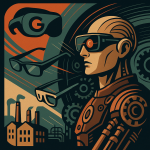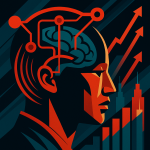Key Points
- Amazon is testing humanoid robots for package delivery using a challenging obstacle course to train gait, grasping, and environment interaction.
- The robot delivery effort involves significant contributions from Chinese tech firms, including Unitree Robotics (Yǔshù Kējì 宇树科技) for hardware.
- Software for the robots leverages AI models like DeepSeek-VL2 from DeepSeek (Shēndù Qiúsuǒ 深度求索) for visual and language understanding, and Alibaba’s (Ālǐbābā 阿里巴巴) Qwen model for pathfinding.
- This move aims to significantly reduce logistics costs, which currently account for about 20% of Amazon’s retail revenue.
- Analysts estimate that robots handling 30-40% of US retail shipments by 2030 could save Amazon $10 billion USD annually.

Amazon’s robot delivery drivers are on the horizon, and the tech behind them is seriously cool, involving some big names from China.
Imagine a robot, not a person, dropping off your next Amazon package.
It sounds like sci-fi, but according to multiple reports, Amazon is deep into testing humanoid robots for exactly this purpose.
What’s super interesting is the blend of global tech making this possible.
For the physical robots, Amazon is trying out a few models, including one from the Chinese firm Unitree Robotics (Yǔshù Kējì 宇树科技).
On the brains side of things (the software), Amazon is cooking up simulation software using powerful models like DeepSeek-VL2 from DeepSeek (Shēndù Qiúsuǒ 深度求索) and the Qwen model from Alibaba (Ālǐbābā 阿里巴巴).
Let’s dive into how Amazon’s robot delivery drivers are shaping up.
Amazon’s Humanoid Robot Boot Camp: Prepping for Real-World Deliveries
So, how do you train a robot to deliver packages?
Amazon has reportedly set up a challenging indoor obstacle course in San Francisco.
Think of it as a robot boot camp!
This course isn’t just a flat surface; it includes:
- Stairs
- Lawns
- Gate systems
They’re testing everything from the robot’s gait balance and package-grasping skills to how it interacts with its environment.
The goal? To see if these robots can truly handle real-world delivery chaos and eventually take over some human delivery roles.
But wait, there’s more!
Amazon has even parked a Rivian electric delivery van in this training zone.
This helps them fine-tune how robots will interact with delivery vehicles.
They’re building a full “van-to-robot-to-door” workflow, covering:
- Automatic door unlocking on the van
- Package retrieval by the robot
- Planning delivery routes based on addresses
Amazon isn’t shy about its ambitions here.
They’ve even formed a new Agentic AI team within Lab126 (their hardware R&D division) to push “Physical AI” research.
The dream is to create robots that can understand and execute tasks based on natural language instructions – basically, tell the robot what to do, and it does it.
Why the Big Push for Robot Delivery? It’s About the Benjamins (and Efficiency)
Amazon is one of the world’s retail titans, and logistics and delivery are a massive part of their operation – and a massive cost.
Consider this: Morgan Stanley (Mó gēn Shì dān lì 摩根士丹利) analyst Brian Nowak pointed out that logistics costs gobble up about 20% of Amazon’s retail revenue.
That’s a huge slice of the pie.
Now, imagine if robots could handle a chunk of that.
The same analyst projected that if 30-40% of Amazon’s US retail shipments were managed by robot warehouses by 2030, Amazon could slash its costs by a cool $10 billion USD annually. Cha-ching!
This explains Amazon’s relentless investment in logistics automation.
They’re building an automated empire, from warehouse robots to, potentially, delivery bots.
At the 2024 Amazon Global Selling Summit, company execs revealed they’ve already deployed over 750,000 robots in their global logistics network.
These aren’t just your Roomba-type bots; they include sophisticated pick-and-place robots and autonomous mobile robots for warehouse tasks.
If these humanoid robot delivery tests pan out, we could see robots moving beyond the warehouse and onto our streets.
Analysts are watching closely. Success here wouldn’t just transform Amazon’s delivery game; it could send ripples across the entire express delivery industry.
- If robots handle: 30-40% of US retail shipments by 2030
- Estimated Annual Savings for Amazon: $10 billion USD

Find Top Talent on China's Leading Networks
- Post Across China's Job Sites from $299 / role
- Qualified Applicant Bundles
- One Central Candidate Hub
Your First Job Post Use Checkout Code 'Fresh20'

The Tech Dream Team: Unitree, DeepSeek, and Alibaba Powering Amazon’s Robots
Yesh Dattatreya, who heads Amazon’s Lab126 and is a robotics scientist, mentioned that the final look of the robots, how many will be deployed, and the exact timeline are still under wraps.
However, media reports are buzzing that the tech powering these delivery droids has significant contributions from Chinese tech companies.
Hardware: Enter Unitree Robotics
On the hardware front, Amazon is experimenting with a few different humanoid robot designs.
One notable contender is from Unitree Robotics (Yǔshù Kējì 宇树科技), a Chinese company making waves in the robotics space.
This isn’t Amazon’s first rodeo with humanoids.
They’ve previously used “Digit” robots from the American startup Agility Robotics in their warehouses.
But outdoor delivery is a whole different beast compared to a controlled warehouse environment.
Delivery robots need to be smart and agile enough to:
- Avoid pedestrians
- Handle surprise weather changes (rain, anyone?)
- Navigate tricky and often unpredictable routes
By testing various robot forms, Amazon aims to gather a wide range of data to speed up the training of its new robot models. More data, smarter robots.
Interestingly, Unitree Robotics founder Wang Xingxing (Wáng Xīngxīng 王兴兴) recently addressed some chatter about Unitree robots being used in fighting competitions and even dancing at an AI conference.
He clarified their vision: “Our ultimate goal is to use advancements in AI technology to help humans perform strenuous work. Before achieving this ultimate goal, we show the real progress of robots and generate some business value by participating in performances.”
So, those cool robot dances? All part of the journey to practical application.
Software: DeepSeek and Alibaba’s AI Smarts
Now, for the brains behind the brawn.
Amazon is developing sophisticated software for these simulation robots, and it’s leveraging models from DeepSeek (Shēndù Qiúsuǒ 深度求索) – specifically their DeepSeek-VL2 model – and Alibaba (Ālǐbābā 阿里巴巴), using their Qwen (Tōngyì Qiānwèn 通义千问) model.
Why these models?
DeepSeek-VL2 is a multimodal visual language model.
Think about what a delivery robot needs to “see” and “understand”:
- Recognizing house numbers and signs via its cameras.
- Interpreting obstacles in its path.
- Processing user notes like “leave it in the locker” using semantic understanding.
This requires both strong visual processing and language comprehension – exactly what DeepSeek-VL2 offers.
Then there’s Alibaba’s Qwen technology. Its pathfinding algorithms are crucial for enabling robots to react intelligently to unexpected road conditions.
A sudden detour? A blocked path? Qwen helps the robot figure it out.
Amazon team members have confirmed they’re using open-source large language models like those from DeepSeek and Alibaba Cloud’s Qwen (Tōngyì Qiānwèn 通义千问).
These models help robots gain a much better grasp of their surroundings and plan their actions more effectively.
Industry insiders see this as a clear signal: in the global push for logistics automation, the hardware manufacturing prowess and cutting-edge AI capabilities of Chinese enterprises are becoming fundamental “new infrastructure” in this intelligent era.
The future of Amazon’s robot delivery drivers looks set to be a fascinating blend of global innovation.
- DeepSeek-VL2 (from DeepSeek): Multimodal visual language understanding (seeing and interpreting surroundings, processing instructions/notes).
- Qwen Model (from Alibaba): Pathfinding and intelligent reaction to changing route conditions.

ExpatInvest China
Grow Your RMB in China:
- Invest Your RMB Locally
- Buy & Sell Online in CN¥
- No Lock-In Periods
- English Service & Data
- Start with Only ¥1,000






